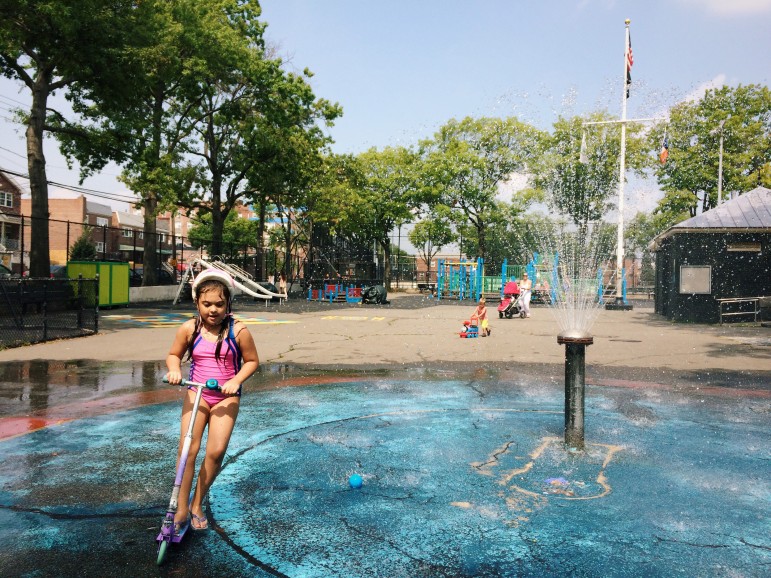
Kara Chin
Scooting and splashing through the cooling spray at Loreto Playground.
Splashing in fountains. Praying. Watching children and grandchildren. Reading. Making new friends. And, of course, complaining – about too much litter, not enough restrooms, neighbors who party hardy.
Those are just a few of the things Bronx residents were doing in their neighborhood parks and playgrounds on a recent late-summer midweek day.
City Limits sent reporters out to parks across the Bronx on September 2 to record some of those slice-of-life moments, showing people and places in a series of snapshots of the way Bronx residents use and rely on parks and playgrounds.
New York City has more than 1,700 parks and playgrounds, about 300 of them in the Bronx, which has more greenspace, according to the city – about 25 percent – than any other borough. The Bronx, known for New York City’s main zoo and the Bronx Botanical Gardens, boasts two of the three largest parks – Pelham Bay Park and Van Cortlandt Park, home to America’s first public golf course and the borough’s largest freshwater lake.
Here are scenes from parks large and small all across the borough. — Megan Cerullo
On a tranquil day in Crotona Park, Jazmin Cintron was taking a break from class. Joined by three classmates from the Bronx Educational Opportunity Center on nearby Bathgate Avenue, she takes refuge from the heat, perching on a rock ledge in the shade. The park boasts playgrounds, basketball courts and a swimming pool, but it’s nearly empty on this sunny September afternoon. “It gets more crowded as the day goes on. It’s too hot right now,” she said.
Cintron, 38, lives on Fordham Road and often takes her three children to Crotona Park, which she says is more popular on the weekends and in the evenings. She says it’s a good place to go swimming, to barbecue and to bring her two dogs. “After nine, they can come off the leash,” she said, smiling.
At that moment, Cintron was more concerned with an impending math exam. She and her classmates had 20 minutes until they had to go back to their quantitative reasoning class at the Educational Opportunity Center. “We’re just releasing a little stress,” said Lucinda Martinez, 26.

Nomin Ujiyediin
Crotona Park is valued by area residents for its tranquility.
They said they often come to Crotona Park to relax and talk between classes. The students said that nearby apartments are filled with families that frequent the park. But aside from the occasional cyclist or parent pushing a stroller, they said, there’s not much to disturb them on their breaks. The benches at the edge of the nearby the pond were empty. The shouts and laughter from the pool are too far away to hear.
Cintron, Martinez and their friends said they know that school is the path to a better life. They talked about their dreams: owning a motorcycle, becoming a tattoo artist, making enough money to pay rent, making something of themselves. It’s a tough neighborhood, they agreed, but they are hoping school will help things will get better. — Nomin Ujiyediin
Three boys hit a tennis ball on the handball court, four teens played a game on the basketball court, and a girl ran through the spray shower. In the middle of a summer day, the only vacant area of Loreto Playground was the roller hockey field.
The park is just off Morris Park Avenue, a street lined with a Dunkin Donuts, a Citibank branch, a flower shop, and several delis, pizza joints, nail and hair salons.
One boy saw another with some apples.
“Can I have one?” the boy asked.
“No,” said Dimitris, the boy with the apples. “I don’t know you.”
“I’m Anthony!” the other boy exclaimed.
A few seconds later, an older woman who later identified herself as Theodhora Xagxai, Dimitris’ grandmother, handed the other boy a slice of apple.
“It’s from our backyard,” Dimitris told the boy. — Kara Chin
Rainey Park, in the Longwood section of the Bronx, is a popular neighborhood leisure spot, recreation area and all-purpose hangout nestled among 4- and 6-story apartment buildings and a local high school.
But some local residents in the park say it could be even better.

Stephanie Daniel
A quiet day at Rainey Park.
On a recent weekday afternoon, young men played catch while groups of older people congregated around benches dotting the lawn near the two dusty baseball diamonds that on Fridays are home to the neighborhood softball league, typically drawing small but noisy crowds to cheer for their local heroes.
One regular player, Christopher Polanco, 31, who lives nearby, said the city should do a better job maintaining the park. Turning his side, he showed a large, pink scrape on his lower leg from sliding into second base. “The field has rocks and dirt,” he said.
Michael Santos, 31, who was washing his car across the street, said the city should add more exercise equipment, such as pull-up and dip bars, for people who want to work out in the park. — Stephanie L. Daniel
Rita Bonsu, a live-in nanny from Ghana, brought her four grandchildren to an almost deserted Soundview Park on a recent weekday afternoon. The kids ran through the field’s bleachers below while Bonsu stretched her legs on the sloping lawn and spoke to her sister on the phone.
Other than Bonsu’s family and a few schoolchildren exercising near a track, the park was sparsely filled. It was quiet other than the whir of construction at a football field on the park’s northwest edge. Under a cluster of oak trees, Bonsu sat with bags strewn around her. She stared straight ahead over the field, then glanced at her grandchildren running back and forth in the park.
“It’s very peaceful and refreshing,” she said, smiling. “I’m coming to pray and relax myself with my grandkids. Five years—every summer.”
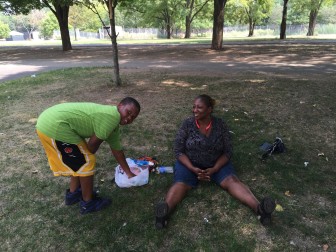
Nico Grant
Prayer and play mixed for this grandmother and grandchild in Soundview Park.
Sometimes, she said, she comes with fellow congregants of St. Luke’s Catholic Church. “Even my church always make a picnic here every year,” she said.
Bonsu said she emigrated to the Bronx six years ago, and has been a Soundview resident for five years. She said she works four days a week in the Bronx and brings her family to the park on her days off. “I’m coming with my grandkids to do the exercise..”
Bonsu says the park is busier on the weekends. “On the summer, when I come her on the weekend, I met lots of people here, from their churches. And a lot of families come here with their canopies and a lot of the children play,” she said.
“I play soccer here with friends and my sister,” her 6-year-old grandson Kwadwo said. — Nico Grant
Aqueduct Walk
At the ends of Aqueduct Walk, a narrow strip of grass and pavement that runs two blocks along Aqueduct Avenue East in the Bronx’s University Heights neighborhood, residents say they live in very different neighborhoods.
Aqueduct Walk, a city park with a playground and basketball court, is sandwiched between 181st Street to the south and Fordham Road to the north. On a recent midweek afternoon, several people on the southern end of the park were not reluctant to poor-mouth people who live at the northern end.
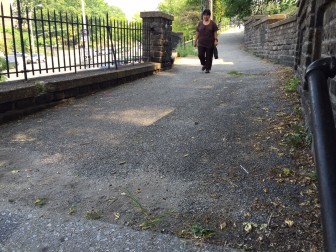
Joseph Jaafari
Aqueduct Walk is a small park connecting what some residents say are two very different neighborhoods.
“This side has more responsible people, I’d like to think,” said Ira Brown, a carpenter who lives Buckeye apartment building off 181st Street and University Avenue.
Sitting outside of his apartment, Brown, 32, said that the southern end is cleaner, partially due to the Bronx Community College’s proximity, just across the street.
“People around here, they just want to go to school,” said BCC student Brian Lopez, 20, while waiting for a classmate in the park.
At the other end of the park, a short walk away, on Fordham Road near a Bx12 bus stop, benches were occupied by sleeping people. Two people who said they were local residents identified an odor in the air as “K2,” an incense that the federal Centers for Disease Control and Prevention have warned is also used as a synthetic marijuana that has killed 15 people this year.
“You come around here at night, and there’s a bunch of them,” said musician Kenny Mitchell, 18, pointing to a man passed out on a bench.
Another resident, Tisha Joseph, 17, said that the park acts as an invisible fence for two gangs that reside on opposite sides of Fordham Road but meet in Aqueduct Walk to fight.
Joseph, who moved to University Heights from the Bedford-Stuyvesant neighborhood in Brooklyn, said the area around the park needs to be improved dramatically. “Bed-Stuy might be do or die,” she said, “but this is something different. This is worse.” — Joseph Darius Jaafari
On a muggy midweek morning in late summer, the tinkling of fountain water was a backdrop to children’s laughter and languid conversations at Joyce Kilmer Park. The park, between 161 and 164th streets, is bordered on one side by the Grand Concourse, across from Bronx Supreme Court, with sweeping views of Yankee Stadium.
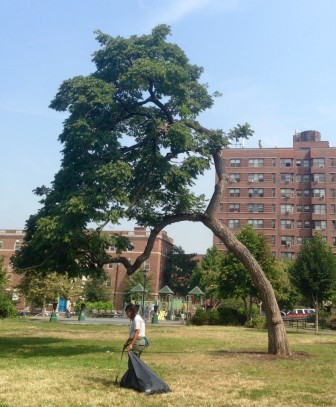
Samantha Lee
The poet himself might have had something to say about this tree in Joyce Kilmer Park.
The park was full of people, from retirees to small children tended by parents. And almost all of them – the adults, anyway, seemed to have a complaint. Or two. Several local residents said the park, built in the shadow of multibillion-dollar Yankee Stadium, has insufficient maintenance and lax security. They said they depend on the park – the neighborhood is one of the poorest in New York City, with one of the highest teen birth rates and one of the highest concentrations of children – but pointed out problems with litter, dying grass, a lack of restrooms and other residents’ cookout habits.
Ralph Johnson, a retired asbestos removal worker who has lived in the neighborhood since 1967, said, “People who barbecue should be more considerate with their clean up.”
Kim Lassiter, a child-care provider and resident for more than 20 years, agreed. “Our grounds should be kept much better,” she said, watching the children in her care play. “Central Park is a lot more green and there are more fresh trees. That’s unfair. Put more money in the park. This is for children and not for cookouts and barbecues.”
Margaret John, complained that although she enjoyed the park, there was no place for her or her children to go to the restroom.
“This is one of the most popular parks in the area, yet there’s no bathroom,” said Jaitnarain Bharat, 70, a retiree originally from Guyana who lives two blocks away.
Milton Walker, a retiree who comes to the park daily to read, said, “The park is not being kept clean as it should be. We had a path that was roped off and green but people walked through it.”
Eddie Nieves, 55, who moved to a nearby senior citizens facility six months ago, gestured to a NYC Parks and Recreation employee sweeping up litter. “This park is filthy most of the time—people hold barbecues here over the weekend, and leave all their trash lying around.”
Others cited problems at night and on weekends when people party in the park. “People aren’t supposed to smoke and drink in the park, but I’ve witnessed drug use, knifings, drunken fights,” said Juana Pagero, 58, a hotel housekeeper who has lived in the neighborhood for 37 years. “My children used to play here, but my grandchildren don’t come here, ever.” — Samantha Lee and Rachael Stark
The children ran up to Daniel Pena that hot summer day, asking permission to jump in and splash around, the moment the St. James Park water spouts began shooting up.
Pena, who runs the Rayito De Luz Daycare a few blocks away from the Bronx park, said he brings eight children to the park four days a week. He watches the kids carefully, but still wishes there were more eyes on the playground.
“I think the police or someone for the parks should look out for it because if something happens, no one is around,” Pena said.
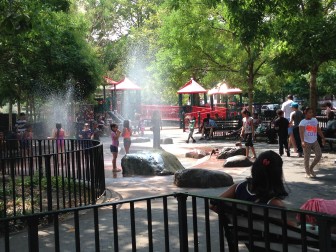
Doha Madani
Children of Rayito De Luz Daycare cool off in the sprays of St. James Playground’s water spouts after getting permission from caretaker Daniel Pena.
Pena said he worries about some of the homeless people he has seen at the park. The previous week, he said, a homeless man was smoking marijuana not far from the children in his care. Instead of calling police, Pena approached the man.
“He apologized right away,” said Pena. “They should have someone come around every few hours.”
St. James Park has a recreation center, basketball courts and the playground. Stay-at-home mom Tanya Hassell said she brings her two sons, Michael, 9, and Rashad, 5, to the playground up to three days a week during the summer.
“They like playing and climbing on the rocks. My youngest likes the water mostly,” Hassell said.
Hassell, who said she was born and raised in the Bronx but moved back to the city from Texas about a month ago, added, “I mostly try to bring them to the park to wear them out. They get hyper at night.” — Doha Madani
Van Cortlandt Park
Van Cortlandt Park was breezy and warm on the late summer morning. The elevated subway rumbled past to the west, while three teenaged girls dressed in fluorescent workout gear jogged across a tree-lined field near the historic Van Cortlandt House Museum. The girls, students at Christopher Columbus High School in Allerton, said they had come from preseason track and field practice in the park.
Families set up for cookouts at picnic tables and charcoal grills tucked in shady inlets off paved pathways winding around expansive playing fields. Amanda Arce, 24, sat on the edge of a long picnic table draped in Hello Kitty products for her daughter Destiny’s seventh birthday. Shiny pink streamers hung from low hanging tree branches sway slowly in the light breeze.
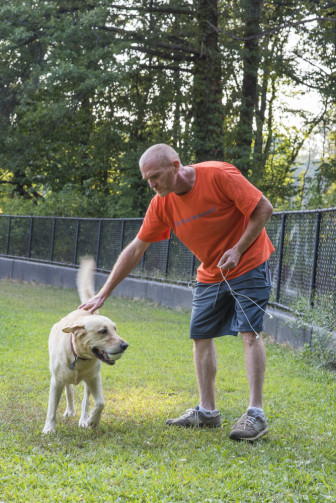
George Goss
Walking the dog in Van Cortland Park.
Arce said her family have come to park many times since moving from Kissimmee, Florida, to Kingsbridge four years ago. “We come here every other day,” she said. “We usually go to the pool first, and then we’ll come to the park after. Barbecue, go to the park, take the kids to the sprinklers.”
The park, the third largest in New York City, boasts baseball and soccer fields, basketball courts, a golf course, numerous playgrounds, a pool, an equestrian center and an historic museum.
At a playground surrounding a sprinkler fountain, mothers at and watched while their children frolicked in the spray.
“We bring our kids almost every day,” said Lulit Hussain, 41. “When you have toddlers it’s very important to make them busy instead of putting them in front of the TV or electronics. The best thing we can offer as a parent is physical activity.”
“Socializing,” Frieda Profeta, 38, chimed in as she struggled to keep hold of her 10-month-old son.
The two mothers said meeting at Van Cortlandt Park is not good just for kids – they said they have become friends, too. — Anna Roberts
Pelham Bay Park was muggy and humming on a recent late-summer morning as toddlers and retirees in Northeast Bronx took to the city’s largest park.
More than three times the size of Central Park, the park is home to a broad range of facilities and recreation opportunities, including playgrounds, a track, golf courses, trails, horseback riding and a beach.
“It’s a fantastic park,” said Castle Hill resident and retired bus driver, Ronald Ruiz, 68. Amid a cloud of dust kicked up by half a dozen local dogs, Ruiz said he comes to the dog park on most days. Sometimes he brings his daughters and his granddaughter for horseback riding.

Lisa Thomson
People brings dogs together -- and vice versa -- at Pelham Bay Park.
Gwendolyn Peek, 53, a retired health care counselor from Castle Hill, said she brings her grandson Aidan to the park two or three times a week to play. As Aidan, 2, attempted to climb up a slide, Peek watched from a swing and talked about why she likes the park. “It’s very peaceful,” she said. “It’s peace and serenity.”
Another retiree, Irma Martinez, 55, said she has been coming to the park since her own children were small. Now that her kids are grown and out of the house, she said, she still comes to exercise and have some alone time.
“I suffer from depression and I feel this makes me happier,” said Martinez, 55. Sitting on a bench with her water bottle in hand, Martinez said she started exercising by walking around the track but has since moved on to using trails, which she said she prefers for the varied landscape. — Lisa Thomson
It was one of those summer days at Vincent Ciccarone Playground, on East 188th between Arthur Avenue and Hughes Avenue, when no one seemed in a hurry.
Two weathered women sat on a park bench, in conversation, speaking Italian. A shirtless young man exercised with outdoor gym equipment. He hung from metal bars and did pull-ups, a music player tucked in his pocket and white ear buds dangling.
Children of different races and ethnicities played on the park’s grounds, not all together, but in groups defined by language. Some spoke English, including the children of parents speaking Italian, but most of the playful shouting was in Spanish.
A boy pushing a toddler fast around a corner tipped the stroller on its side, two wheels off the ground. He made race-car noises, and the baby giggled.
Couples took seats on benches, pulling lunch from plastic bags.
A boy tossed a baseball high in the air, and tried to catch it with a baseball mitt. More often than not, he missed, but then he picked up the ball and tossed it again. When the ball bounced away and almost hit a woman having lunch, the boy retreated to a nearby bench and his father.
A man walked through an open gate on the playground, pushing a cart that read “Don Jose Ices.” He rang a bell and children ran to their parents, begging for money. Clutching coins or a bill in their small fists, they raced to form an excited line in front of the ice man.
At last, someone was in a rush. — Megan Cerullo
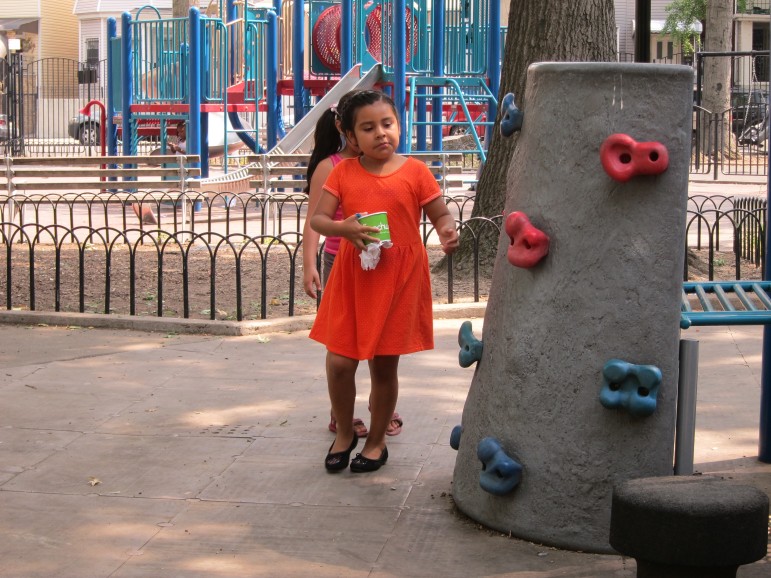
Megan Cerullo
It was a lazy day the last week before school starts at Vincent Ciccarone Playground, on East 188th between Arthur Avenue and Hughes Avenue.








